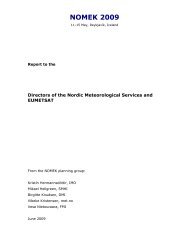International Symposium on Mitigative Measures against Snow ...
International Symposium on Mitigative Measures against Snow ...
International Symposium on Mitigative Measures against Snow ...
You also want an ePaper? Increase the reach of your titles
YUMPU automatically turns print PDFs into web optimized ePapers that Google loves.
<str<strong>on</strong>g>Internati<strong>on</strong>al</str<strong>on</strong>g> <str<strong>on</strong>g>Symposium</str<strong>on</strong>g> <strong>on</strong> <strong>Mitigative</strong> <strong>Measures</strong> <strong>against</strong> <strong>Snow</strong> Avalanches<br />
Egilsstaðir, Iceland, March 11–14, 2008<br />
Barrier built up with geo-cells, under<br />
c<strong>on</strong>structi<strong>on</strong>, Siglufjörður 2006.<br />
Barrier built up with geo-cells, after<br />
completi<strong>on</strong>, Siglufjörður 2006<br />
It is important to note that the top width must be sufficient to operate machinery, especially if<br />
the leeside slope is steep. The 3m usually allocated for the top width is very narrow. At least<br />
6m are needed for trucks to maneuver <strong>on</strong>e the top so usually the final two meters of fill are<br />
built up with an excavator.<br />
5. GROUNDWATER<br />
Groundwater levels in both cut and fill areas are very important. It is essential to lower the<br />
groundwater levels under the dams and barriers as much as possible to increase their stability<br />
and take some measures to maintain these levels and ensure that water has a safe passage out<br />
from under the c<strong>on</strong>structi<strong>on</strong>s. For this purpose trenches have been excavated under the dams<br />
that have been filled with highly permeable material wrapped in geotextile. The most<br />
effective fill materials are st<strong>on</strong>es that can be screened from the scree material. The final<br />
positi<strong>on</strong>ing of these trenches is best selected and adjusted to c<strong>on</strong>diti<strong>on</strong>s encountered when<br />
c<strong>on</strong>structi<strong>on</strong> has started, rather than specifying a grid of trenches. This will allow them to be<br />
positi<strong>on</strong>ed where water is actually flowing. The photographs below show typical trenches.<br />
Drainage trench, Siglufjörður, 1999. Drainage trench, Flateyri, 1997.<br />
194 Avalanche protecti<strong>on</strong> – some aspects of design and c<strong>on</strong>structi<strong>on</strong>











